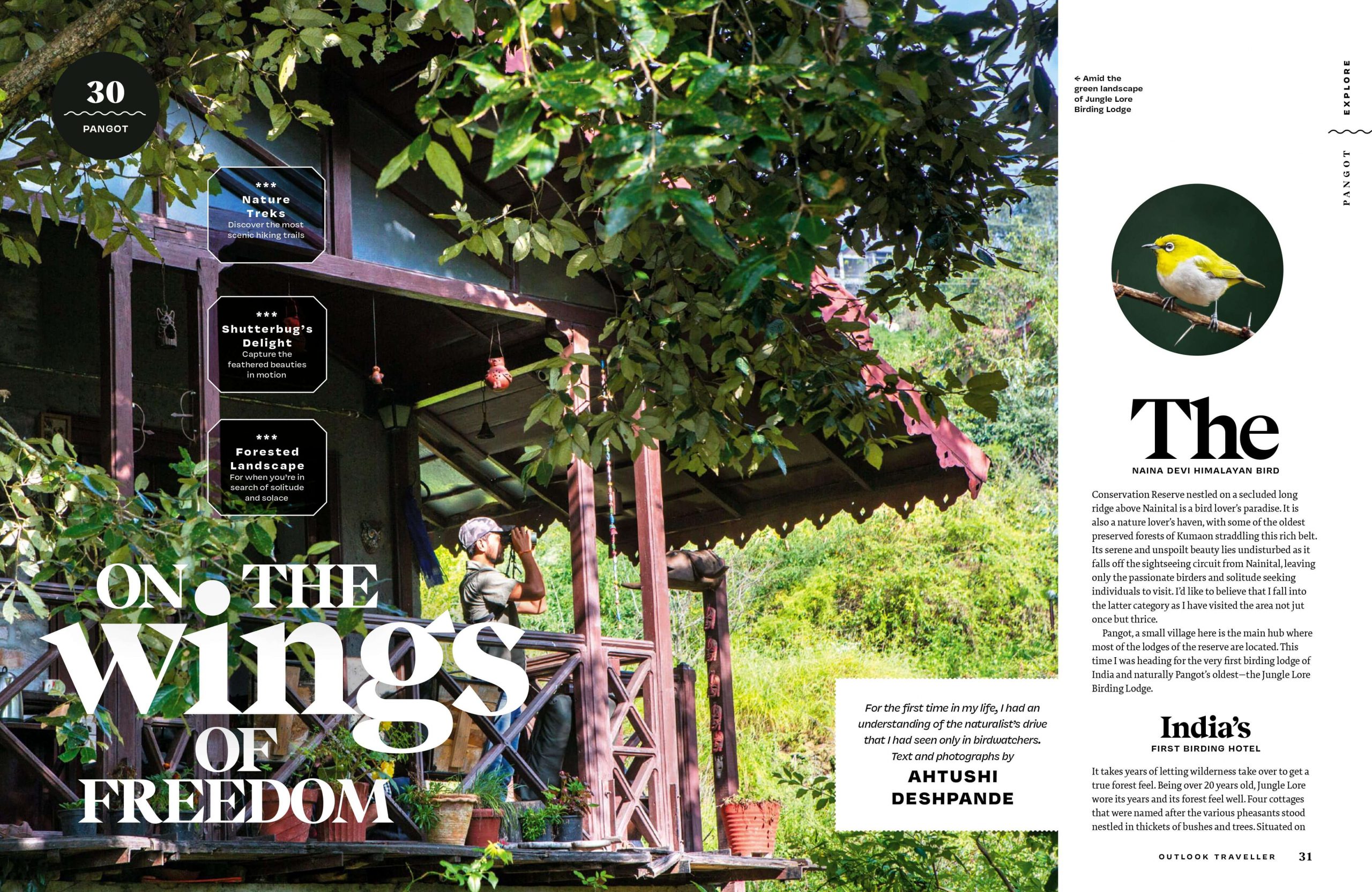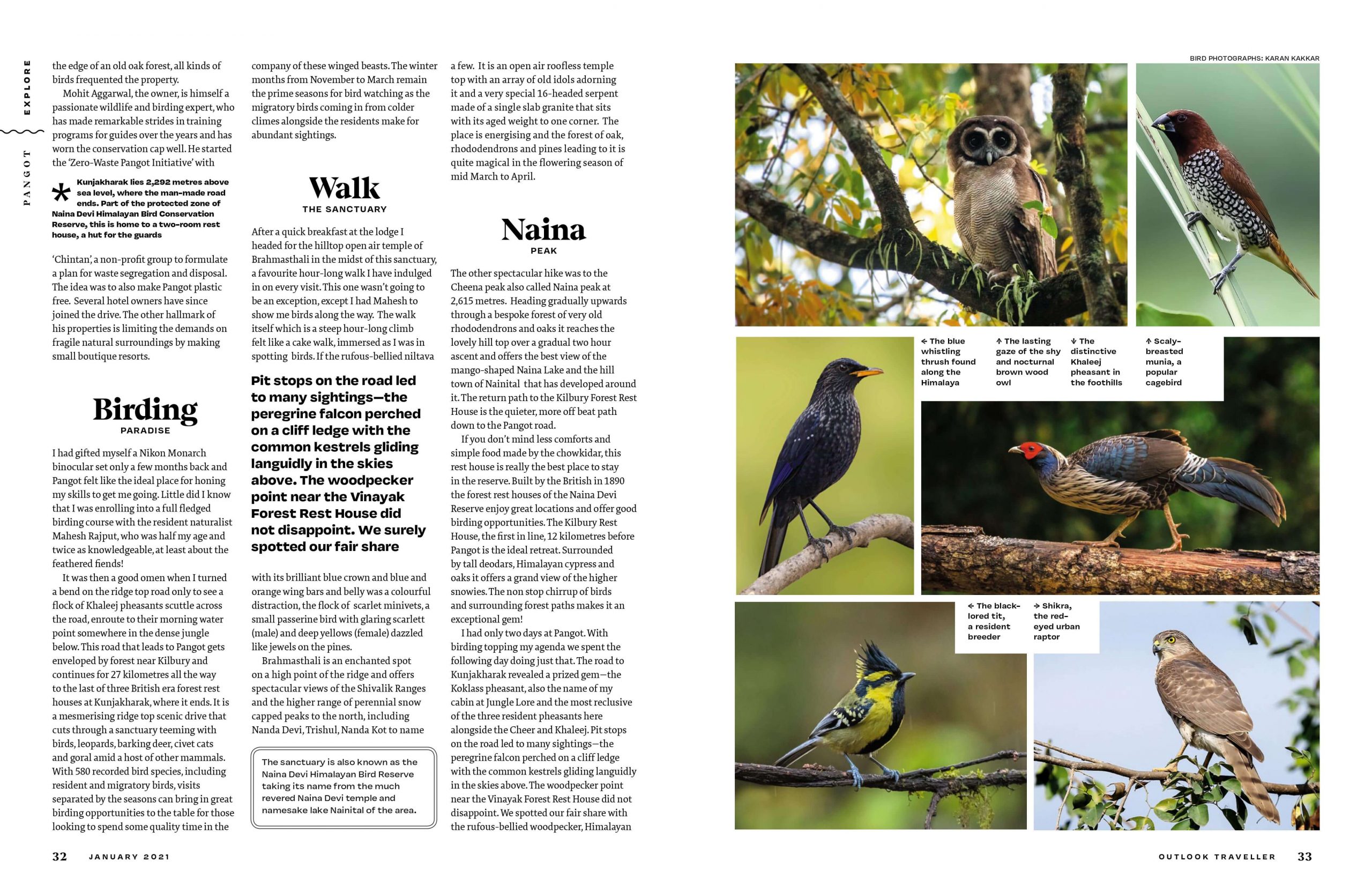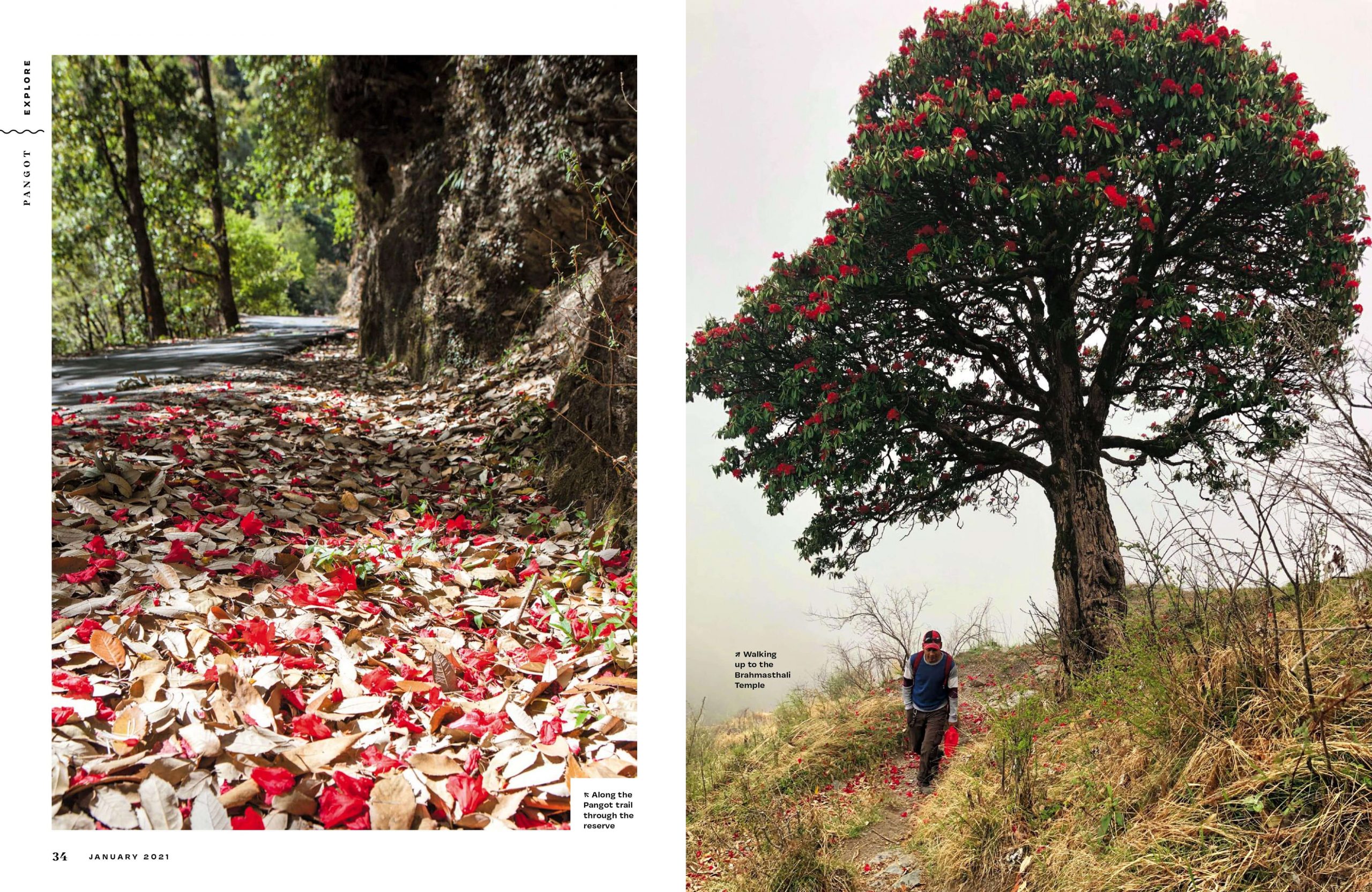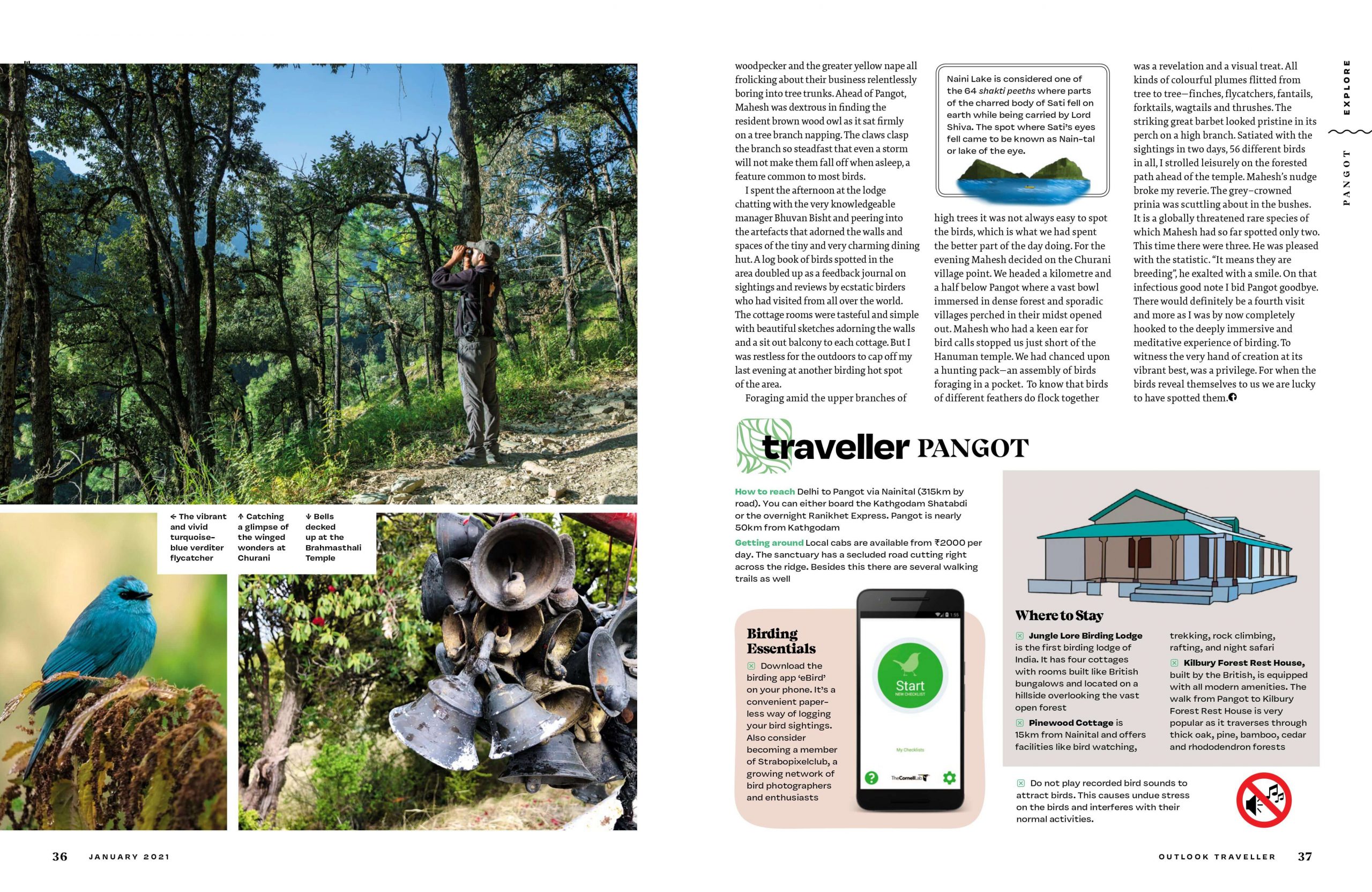



More than 250 species of birds have been recorded in the area. One can have excellent birding opportunities in the lodge itself. Besides, there are numerous walks through the terrace fields into thickly wooded oak forest which are extremely rewarding.
There are good trails from the lodge to Timla Pani, Ggughu Khan, Kilbury Forest Rest House and on to Cheena Peak. The guide may accompany you on these treks (prebooking required).
Please ‘ask us’ for a checklist
For birding tours visit www.junglelore.com
Woodpecker Point
(Pokhra Dhar)
One of the area’s most reliable birding spots, this is a fairly level 2 km walk from Pangot via both an old British bridle path and the main road. It has a shallow pool (Pokhar) where you can easily glimpse birds such as brown –fronted and grey – hooded woodpeckers, as well as the luminous maroon oriole and jewel-like blue Verditer Flycatcher.
Pangot Nala
This stream runs nearly all year round. As you walk from Pangot to Kilbury, you will cross a bridge after 1 km. Turn right on the path going up from the bridge along the stream. This is excellent picnic territory; take a dip I the pools, even chill your beer in them. Look out for spotted forktails, long-billed thrushes, and brown wood owls.
A very pleasant road meanders down from Pangot to the neighboring villages of Pali (30 min walk), Tusharpani (another 15min) and Baggar (yet another 30 min). Vistas of forested hills, fields of vegetables and slate-roofed houses are the highlights. In springtime, the red rhododendron and white apricot blossoms create a riot of color. The road is car-friendly too.
Another downhill forest trail starts from the main Pangot road, on the opposite side of the post office. You can walk down an easy 2 km to a small Shiva shrine, near which runs a refreshing stream.
A long yet mostly flat trek leads you through the forest reserve of Kilbury from the main Kilbury road. An early morning traverse can be a bonanza for bird lovers and the sounds of nature, birds chirping, leaves rustling is all very peaceful. There is something very calming about walking amidst the lush green forest.
Tanki road bifurcates from the main road and through the Kilbury Forest Reserve has over 150 species of birds, where you can spot anything from the tiny Eurasian treecreeper to the beautiful spotted Forktail, the snarly Lammergeier and Himalayan griffon to the starkly colored Scarlet finch, and the exotic Khaleej pheasant to the Canary Flycatcher.
We provide Swiss tent & camping tents in Pangot for birders who enjoy camping. The tents have a common western-style toilet & hot shower. Tents are lit with emergency lights.
The Swiss tent has an independent toilet and a hot shower. The tent can accommodate two persons on camp cots.
The size of each tent is 16’x10’
Trekking Beyond Pangot
The road beyond Pangot is thickly forested and isolated; you can drive on with no particular goal in view. Four kilometers from Pangot is the village of Guggu Khan (not a difficult walk). Just 2 km onwards is the KMVN’s Sigri Camp, an excellent area from which to see the koklass pheasant. About 2km ahead of this lies Vinayak and its panoramic views.
Recommended Treks Pangot
The popular trekking route from this area starts from Kilbury FRH to Nainital’s well-known China Peaks (now called Naina Peak), or to Tanki Band. From October to March, superb Himalayan views, especially of Nanda Devi, are guaranteed. Ask your hotel to organize a local guide.
Treks
Day Trek – Pangot – Naina Peak – Kilbury – Pangot
We start our day early at 0630hours and begin with a hot cup of coffee/ tea at the dining deck.The area near the dining deck also serves as a feeding ground for the birds who turn up everyday without fail. Sit back and take time to finish your tea/coffee as you watch the birds feed and soak in the fresh mountain air.
After breakfast we start our trek from the lodge and first arrive at the Pangot Village. Its just about 150 meters away and is a small village made of a few houses, local shops and a post office. As we pass through the village we get to watch the local people getting on with their daily routine and helps get a glimpse of the humble local culture, ways and mannerisms. One such house is of Mrs Kanti Budhlakoti, an old army widow, from whose house a magnificient view of Corbett national park area & villages around like kotabagh & pawalgarh where Jim Edward Corbett killed 10ft long tiger which was called ” Bachelor of Pawalgarh ” can be seen. The last house on our way out of the village is extremely attractive with its unique architecture. After walking for about 1.5 kms we reach DHAMDHAMIYA, from where the views of the Himalayan mountains and the nearby villages is a treat to the eyes. From this point, on the right hand side, under the thick oak forests we see the Kilbury Forest rest house camouflaged with its green tin roof.We will make our way there on our way back from Naina peak.
Moving ahead we reach ” AKHORWADI where we take a short 10 minute break.In the earlier days this place was used as a shelter for traders who used to travel from one place to another. Its name “akhorwadi” comes from the fact that it is home to a lot of walnut trees. There is also a drought tree that we come across here which was known for its height but now has been reduced to half due to a lightening attack a few years ago. This place is also a birdwatchers playground and we can spot many like the Himalayan woodpecker, fulvous breasted woodpecker, brown – fronted woodpecker, common kestrel, crested serpent eagle & many more species.
Along the trek we also find a lot of diverse landscapes, flora and fauna. There are deep ravines created in the monsoon seasons and small spring water streams along the way. Ghorgatti has a small thin spring where many animals turn up to have a drink. Salimdhar (salim is the name of a type of grass) is beautiful and is especially spectacular when the fog covers the whole area giving it a cloud like feel.
Upto this point we have done about 5kms and are another 2kms short of reaching the highest point of Nanital. Another 30-40 minutes and we reach a height of 2311 mtrs i.e. 8622 ft from the sea level, known as Naina Peak where wireless centre of forest department is located. This place offers a panoramic view of the Himalayan peaks which you can also view with the help of a powerful telescope. The centre run by the forest department generate electricity through solar panels. As we walk a little further down we get a view of lake city “Nainital”, with its lake, various buildings and playgrounds.
With this picturesque backdrop we stop to have our packed lunch and tea/coffee.We take a break for an hour before we head back to Pangot via Kilbury.
After the much needed break we trek back to Pangot through the Kilbury forest covering a distance of seven kms. Initially you walk down about a kilometre & half towards Nainital, and then turn left towards Kilbury forest. This forest is full of trees mainly oak and rhododendron.This is also a good path to spot many bird species like koklas, kalij pheasants, common kestrel,grey winged blackbird, black red start, bar-tailed treecreeper etc or leopard, Himalayan black bear, civic cat, porcupine, spotted + barking + sambhar deer & wild bore etc. We can also spot the village folk in the forest collecting fodder for their cattle and firewood for their homes. The scenic beauty around reduces your tiredness as you quickly take a 5 minute break.
The Kilbury rest house is just another 3kms. The walk is a little fast paced as its downhill and from the forest rest house we soon walk down to the main road leaving the forest behind. The main road is also although covered with trees on both sides. Another 40minutes and we arrive back at Pangot where we are handed out warm wet towels to freshen up before we are served tea/coffee with cookies.
Retire to your rooms and rest before the bon-fire in the evening where experienced of the trek are shared.
Things to carry : Good trekking/ hiking shoes, water bottle, walking stick (if require the support), a small backpack, pen and diary to note down your observations or just scribble your thoughts, Binoculars for a closer look and of course your camera!
Grade – Easy – moderate.
Children below 8 years are not encouraged for this trek.
In 2017 Asian Adventures along with Chintan began the initiative of Zero waste Pangot. An Initiative which ran workshops with the staff of all hotels and lodges in Pangot. To maintain the pristine, and undisturbed natural areas around Pangot. The training was imparted to segregate waste and improving the well-being of the local people as well as educated the tourists. The idea was to maintain and conserve the Himalayas for future generations.
in 2019 the concept of Eco walks took shape which intended to offer tourists an insight into the impact of human beings on the environment and to foster a greater appreciation of our natural habitats.
2020 Eco walks in Pangot will give an insight to promoting the 4 R’s Refuse, Reuse, Recycle, Reduce as well as the creation of economic opportunities for local communities in form of education and training and certifications of the local youngsters.
Embark on a journey, in the wilderness, in Pangot, amidst the picturesque views and exotic species of birds, away from the city life and work, forget all your woes in the lap of nature.
Jungle Lore Birding Lodge in Pangot will serve as the perfect place for your corporate offsite with its exquisite cottages, surrounded by lush forest, the sounds of nature, delicious fresh food, and adventure activities like Rappelling, Rock Climbing, Trekking, Burma Bridge, etc. Pangot is also a bird watcher’s haven and is very spectacular with its majestic views and serves well to bird watchers and photographers.